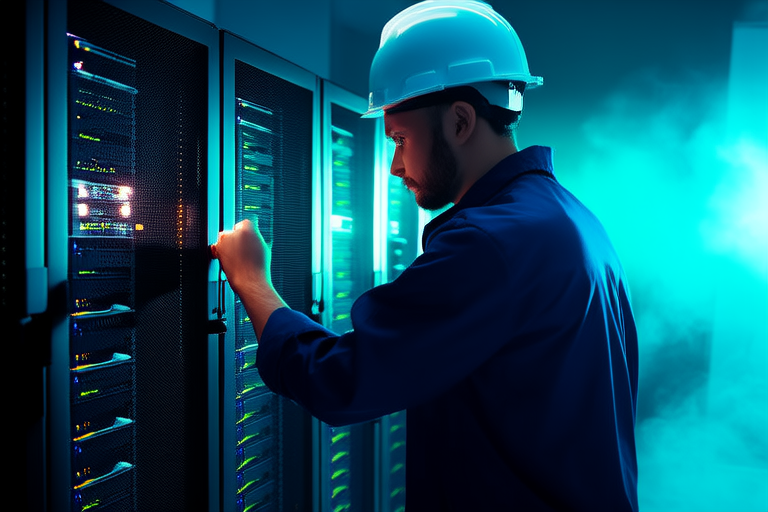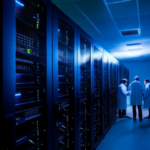Introduction
In the rapidly evolving landscape of technology, cloud computing and edge computing have emerged as two pivotal paradigms shaping the future of data processing. Cloud computing refers to the delivery of on-demand computing resources over the internet, enabling scalable storage, processing power, and applications without the need for local infrastructure. It has become the backbone of modern enterprises, offering flexibility, cost efficiency, and centralized management.
On the other hand, edge computing represents a decentralized approach to data processing, where computation occurs closer to the source of data generation—often at the “edge” of the network. This minimizes latency and reduces the burden on bandwidth by processing data locally rather than transmitting it to a remote cloud server. While cloud computing excels in handling large-scale, complex tasks, edge computing addresses the growing demand for real-time data analysis and low-latency operations.
The integration of these two technologies creates a powerful synergy that leverages their respective strengths. By combining the scalability and computational prowess of the cloud with the immediacy and efficiency of edge computing, organizations can unlock new possibilities in data processing, enabling smarter systems and more responsive applications.
Key Differences Between Cloud and Edge Computing
Cloud and edge computing differ fundamentally in their architectural design, data processing location, latency characteristics, and use cases. Understanding these distinctions is crucial to appreciating how they complement each other in a hybrid model.
Architecture: Cloud computing relies on centralized data centers that house vast amounts of computational resources. These resources are accessed remotely via the internet, making cloud services highly scalable and flexible. In contrast, edge computing operates through distributed nodes located near the data source, such as IoT devices, gateways, or local servers. This decentralization allows edge computing to process data locally without relying on distant cloud infrastructure.
Data Processing Location: In cloud computing, data is typically transmitted to centralized servers for processing and storage. This approach works well for non-time-sensitive tasks but introduces delays when dealing with real-time applications. Edge computing, however, processes data at or near its origin, significantly reducing the time required for analysis and decision-making.
Latency: One of the most notable differences between the two technologies is latency. Cloud-based systems often experience higher latency due to the physical distance between data sources and centralized servers. Edge computing mitigates this issue by performing computations locally, ensuring faster response times critical for applications like autonomous vehicles, industrial automation, and augmented reality.
Use Cases: Cloud computing is ideal for scenarios requiring extensive computational power, long-term data storage, and analytics across large datasets. Examples include machine learning training, big data analytics, and enterprise software hosting. Edge computing, meanwhile, shines in environments demanding real-time insights and minimal latency, such as smart cities, healthcare monitoring, and connected devices within the Internet of Things (IoT).
The Synergy Between Cloud and Edge Computing
The convergence of cloud and edge computing creates a symbiotic relationship that enhances the capabilities of both technologies. By strategically distributing workloads between the cloud and the edge, organizations can achieve optimal performance, scalability, and responsiveness.
Enhanced Efficiency: A hybrid model allows organizations to offload less critical or resource-intensive tasks to the cloud while reserving edge nodes for time-sensitive operations. For instance, in an IoT-enabled factory, sensors at the edge can monitor equipment health and trigger immediate alerts for anomalies, while the cloud handles deeper analytics to predict maintenance needs based on historical trends.
Scalability: The cloud provides virtually unlimited scalability, accommodating fluctuating workloads and expanding storage requirements. Meanwhile, edge devices ensure consistent performance even during peak usage periods by managing localized tasks independently. This combination enables businesses to scale efficiently without compromising speed or reliability.
Real-Time Decision-Making: Applications requiring instantaneous responses benefit immensely from the integration of cloud and edge computing. For example, in autonomous driving systems, edge nodes process sensor data to make split-second decisions about navigation and collision avoidance. Simultaneously, the cloud aggregates data from multiple vehicles to refine algorithms and improve overall system intelligence.
Example Use Case – Smart Cities: In smart city initiatives, edge computing powers traffic lights and surveillance cameras to manage real-time traffic flow and detect incidents. At the same time, the cloud analyzes aggregated data to identify patterns, optimize urban planning, and enhance public safety measures.
Benefits of Integrating Cloud and Edge Computing
Combining cloud and edge computing offers numerous advantages that address the limitations of using either technology in isolation. These benefits span performance improvements, cost savings, security enhancements, and support for emerging technologies.
Improved Performance: By processing data closer to its source, edge computing reduces latency and ensures faster execution of time-critical tasks. When paired with the robust computational capabilities of the cloud, this hybrid approach delivers unparalleled performance across diverse applications.
Reduced Bandwidth Usage: Transmitting all data to the cloud consumes significant bandwidth, especially in IoT deployments with thousands of connected devices. Edge computing filters and preprocesses data locally, sending only relevant information to the cloud. This not only conserves bandwidth but also lowers operational costs associated with data transmission.
Enhanced Security: Storing sensitive data locally at the edge minimizes exposure to potential cyber threats during transmission to the cloud. Additionally, edge nodes can implement encryption and access controls tailored to specific use cases, further strengthening data protection.
Better Support for IoT Devices: The proliferation of IoT devices has created unprecedented demands for efficient data processing. Edge computing addresses these challenges by enabling local data analysis and reducing reliance on cloud connectivity. This ensures continuous operation even in areas with limited or intermittent internet access.
Challenges and Considerations
While the integration of cloud and edge computing holds immense promise, it also presents several challenges that must be addressed to realize its full potential.
Infrastructure Costs: Deploying edge nodes requires investment in hardware, networking equipment, and maintenance. Organizations must carefully evaluate the cost-benefit ratio of implementing edge infrastructure versus relying solely on the cloud.
Data Management Complexities: Managing data across distributed edge nodes and centralized cloud platforms introduces complexities in synchronization, consistency, and governance. Developing robust data management strategies is essential to avoid fragmentation and ensure seamless integration.
Security Concerns: Although edge computing enhances security in some aspects, it also expands the attack surface by introducing additional endpoints. Securing these distributed nodes against vulnerabilities and ensuring compliance with regulatory standards pose significant challenges.
Interoperability Issues: Achieving seamless interoperability between different vendors’ cloud and edge solutions remains a hurdle. Standardization efforts are underway, but compatibility issues may persist until universal protocols are widely adopted.
Future Trends and Opportunities
The synergy between cloud and edge computing is poised to drive transformative advancements in various fields, fueled by innovations in artificial intelligence (AI), 5G networks, and machine learning.
AI and Machine Learning: AI models trained in the cloud can be deployed at the edge to enable real-time inference and decision-making. For example, facial recognition systems in retail stores can leverage edge nodes to analyze customer behavior instantly while relying on the cloud for periodic updates and retraining.
5G Networks: The rollout of 5G technology will amplify the capabilities of edge computing by providing ultra-low latency and high-speed connectivity. This will unlock new possibilities in augmented reality, virtual reality, and immersive gaming experiences.
Autonomous Systems: Industries such as transportation, logistics, and manufacturing will increasingly adopt autonomous systems powered by integrated cloud-edge architectures. These systems will rely on edge computing for immediate actions and the cloud for strategic planning and optimization.
Sustainability Initiatives: As environmental concerns grow, the energy-efficient nature of edge computing will play a vital role in reducing carbon footprints. By minimizing data transfer to the cloud, organizations can lower energy consumption and contribute to greener IT practices.
Conclusion
The fusion of cloud and edge computing represents a paradigm shift in data processing, revolutionizing industries and paving the way for smarter, faster, and more efficient systems. By leveraging the strengths of both technologies, organizations can achieve unparalleled levels of performance, scalability, and responsiveness. From enhancing real-time decision-making to supporting the burgeoning ecosystem of IoT devices, the synergistic relationship between cloud and edge computing addresses the evolving demands of modern applications.
Despite the challenges associated with implementation, ongoing advancements in AI, 5G, and machine learning promise to overcome existing barriers and unlock new opportunities. As we move forward, the integration of cloud and edge computing will continue to shape the technological landscape, empowering businesses to innovate and thrive in an increasingly interconnected world.


